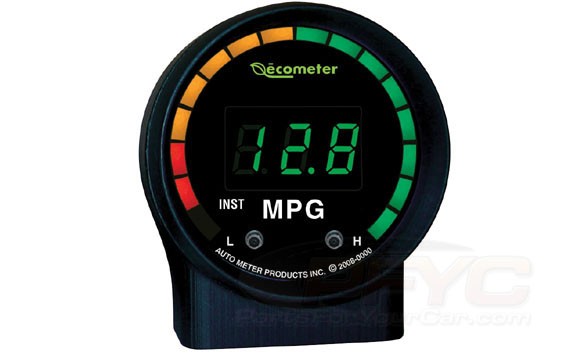For drivers keen on maximizing fuel economy, understanding real-time and average miles per gallon (MPG) is invaluable. The auto meter OBD2 fuel consumption gauge, specifically the ecometer, promises to deliver just that, plugging directly into your vehicle’s OBD2 port to provide insights into your car’s fuel efficiency. After several tank fill-ups and real-world driving with this mpg gauge, here’s an in-depth review focusing on its practicality and how it can help you achieve better fuel economy.
 Ecometer Fuel Consumption Gauge
Ecometer Fuel Consumption Gauge
The ecometer boasts four operating modes: Instantaneous MPG (MPG-inst), Average MPG (MPG-avg), Miles Per Hour (MPH), and Revolutions Per Minute (RPM). While the allure of real-time data is strong, in practice, the MPG-inst, MPH, and RPM modes tend to fluctuate significantly, making it challenging to derive consistent, actionable information. The readings in these modes jump around considerably, which can be distracting and less useful for steady driving analysis.
However, the MPG-avg mode emerges as the most genuinely beneficial function. This mode provides a smoothed average of your fuel consumption, offering a more stable and reliable metric for assessing your driving habits’ impact on fuel economy. For those primarily interested in tracking and improving their vehicle’s fuel consumption and achieving eco economy, the average MPG display is where the ecometer truly shines.
Calibration is a crucial aspect of any fuel consumption gauge. The ecometer uses a single calibration setting labeled “EFF=XXX,” seemingly influencing both the instantaneous and average MPG readings. The device arrives with a preset value of EFF=100, but this can be adjusted from 60 to 140. While the EFF setting is displayed as an integer, it’s suspected to function as a decimal efficiency value (e.g., 100 equating to 1.00 or 100%).
Initial tests with the default EFF=100 setting revealed that the MPG-avg readings were overestimating fuel efficiency compared to actual tank fill-up calculations. Over three tank cycles, the meter consistently showed higher MPG figures than what was calculated at the pump:
- Tank #1: Meter Reading significantly higher than actual MPG.
- Tank #2: Meter Reading significantly higher than actual MPG.
- Tank #3: Meter Reading slightly higher than actual MPG.
To rectify this discrepancy and achieve more accurate fuel consumption readings, the EFF setting was adjusted downwards to EFF=90. This adjustment yielded a closer alignment between the ecometer’s MPG readings and the MPG calculated from tank fill-ups.
- Tank #4: Meter Reading now closely aligned with actual MPG after EFF adjustment.
These results suggest that for this particular vehicle, a Pontiac with a Toyota 1.8L engine (2ZR-FE), an EFF setting in the range of 0.88-0.90 provides a more accurate representation of fuel economy. Further tank fill-ups are recommended to solidify this finding and fine-tune the calibration.
The calibration process, although not explicitly detailed in the user manual, can be understood through a simple formula:
EFF(new) = EFF(old) * [ mpg(tank) / MPG(meter) ]
This formula allows users to calculate a new, more accurate EFF value based on the previous setting, the MPG calculated at the fuel pump (mpg(tank)), and the MPG-avg value displayed by the ecometer (MPG(meter)). This straightforward calibration method empowers users to personalize the gauge for their specific vehicle and driving conditions, enhancing the accuracy of the fuel consumption data.
It’s important to note that the ecometer‘s calibration is limited to a single EFF value. This simplicity means there are no separate adjustments for distance (MPH) or fuel volume (gallons). While this streamlined approach simplifies operation, it also implies that the gauge may not automatically compensate for modifications like tire size changes, which can affect odometer readings and consequently, fuel economy calculations.
Regarding the RPM and MPH displays, both are presented as 3-digit readings. RPM is shown in thousands (e.g., 1.42 representing 1420 RPM), offering accuracy to the nearest 10 RPM. MPH is displayed with one decimal place (e.g., 64.9 mph). However, both readings exhibit a noticeable “jumpiness,” fluctuating by a few digits, which can make precise real-time monitoring somewhat challenging. This jitter in the readings might be a limitation in the sensor’s responsiveness or the display’s refresh rate.
In conclusion, the auto meter OBD2 fuel consumption ecometer is a useful tool, particularly for its MPG-avg function, in helping drivers monitor and potentially improve their fuel economy. While the instantaneous readings may be less practical due to their volatility, the average MPG provides valuable data for eco economy driving habits. The single-point calibration, while simple, requires user adjustments to achieve accuracy, and the RPM and MPH readings have some display limitations. Overall, for drivers focused on fuel consumption and seeking an economy mpg gauge to enhance their eco driving efforts, the ecometer offers a worthwhile, albeit imperfect, solution. Further testing and fine-tuning of the calibration will likely maximize its benefits for fuel consumption monitoring.